Shasta daisy care is easy, making this a popular perennial for gardeners of all levels. Their sunny yellow centers and crisp white petals brighten borders, flower beds, and cottage gardens with minimal effort.
The plant thrives in full sun and well-draining soil. It will reward you with more blooms each year as it naturalizes in the garden. Deadheading and occasional division help this plant thrive.
In this guide, you’ll learn everything you need to know to keep Shasta daisies healthy and blooming. From planting and watering to dividing and winter care, these tips will ensure your daisies return stronger each season.
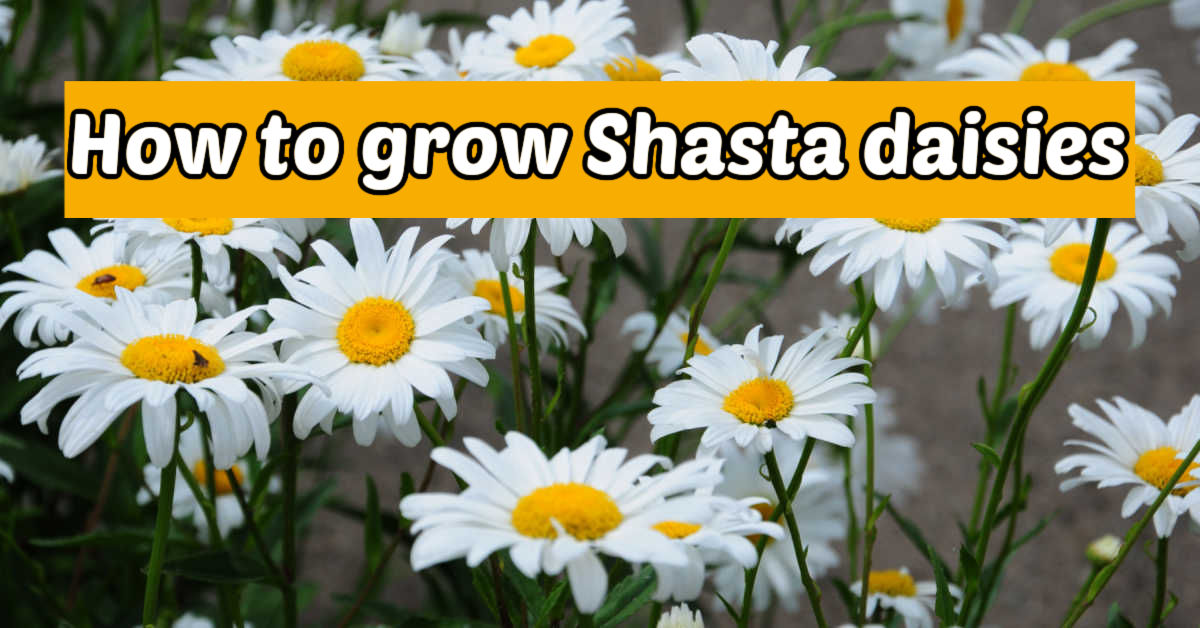
The Gardening Cook is a participant in the Amazon Affiliate Program. This post may contain affiliate links. I earn a small commission, at no extra cost to you if you purchase through an affiliate link.
Growing Shasta daisies overview
Here is a quick guide to the care of Shasta daisies:
- Common name: Shasta daisy
- Botanical name: Leucanthemum × superbum, formerly Chrysanthemum × superbum
- Family: Asteraceae
- Plant type: Perennial
- Sunlight needs: Full sun
- Soil requirements: Well-draining, fertile soil
- Soil pH: Slightly acidic to neutral
- Maintenance level: Low
- Bloom time: Early summer to early fall
- Flower color: White with a yellow center
- Mature size: 2 to 3 feet tall (60-90 cm), and 1 to 2 feet wide (30-60 cm)
- Hardiness zones: USDA 5-9
- Toxicity: Mildly toxic to both humans and pets
Planting Shasta daisies
You can grow Shasta daisies by either sowing seeds, planting seedlings, or planting established plants.
If you plant Shasta daisy seeds or seedlings, you can expect blooms the year after planting. Established plants will flower the same year.
Planting Shasta daisy seeds
Shasta daisies grow easily from seeds. When planting Shasta daisy seeds, you can sow them directly into the garden.
Plant seeds ¼ inch (6mm) deep or scatter them and rake them into the soil. They will germinate in 15-20 days.
When the plants are 1-2 inches (2.5-5 cm) tall and have developed their first set of leaves, thin them by removing the weakest seedlings. After thinning, the seedlings should be spaced 12-24 inches (30-60 cm) apart.
Growing Shasta daisy seedlings
Instead of directly sowing Shasta daisy seeds, you can start seeds in peat pots indoors, or in containers in a cold frame during autumn or early spring.
After the danger of frost has passed, plant your Shasta daisy seedlings 12-24 inches (30-60 cm) apart. Dig a hole twice the diameter of your Shasta daisy plant container to give it room to grow and spread out.
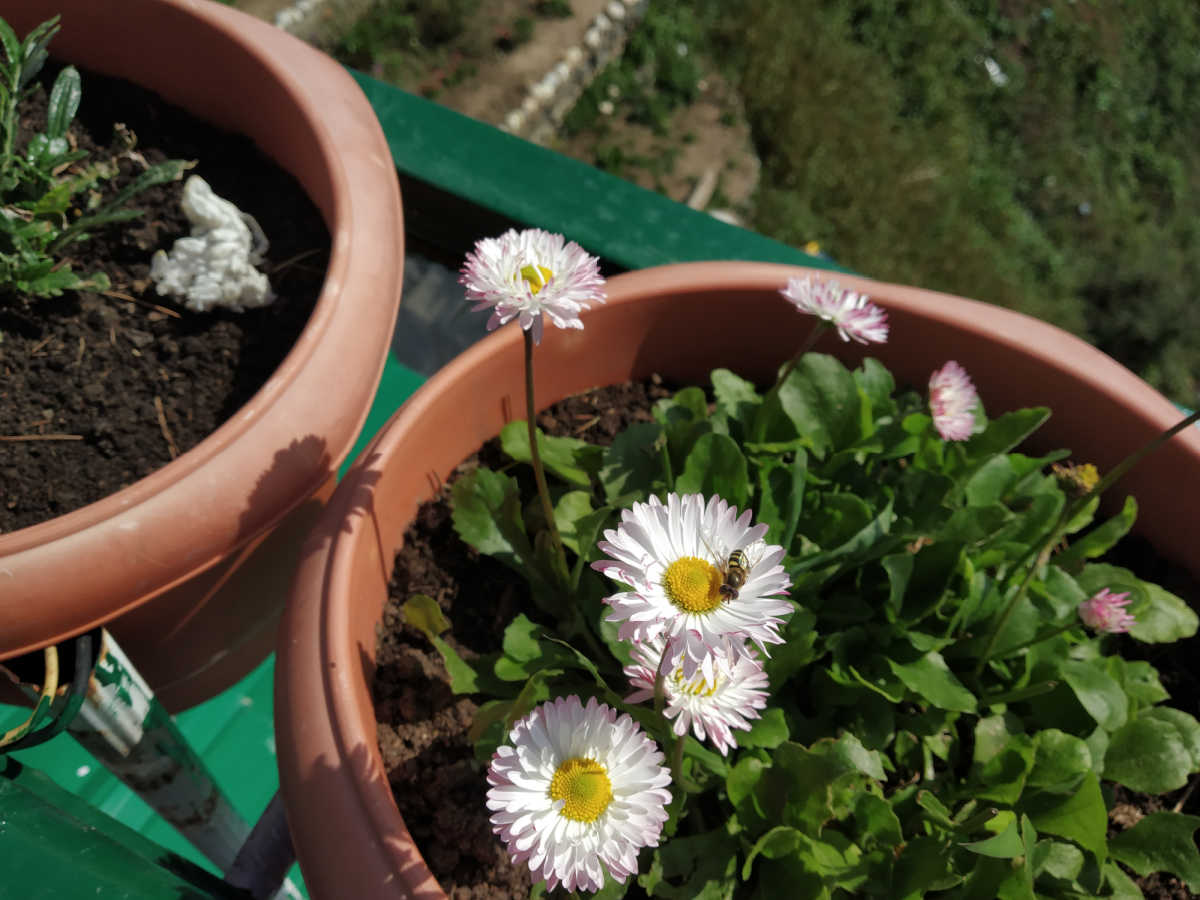
Planting established Shasta daisies
You can also purchase established plants from a garden center in the spring.
When planting them in your garden, space them 12-24 inches (30-60 cm) apart. Dwarf varieties of Shasta daisies can be planted 12-18 inches (30-45 cm) apart, since these plants are smaller.
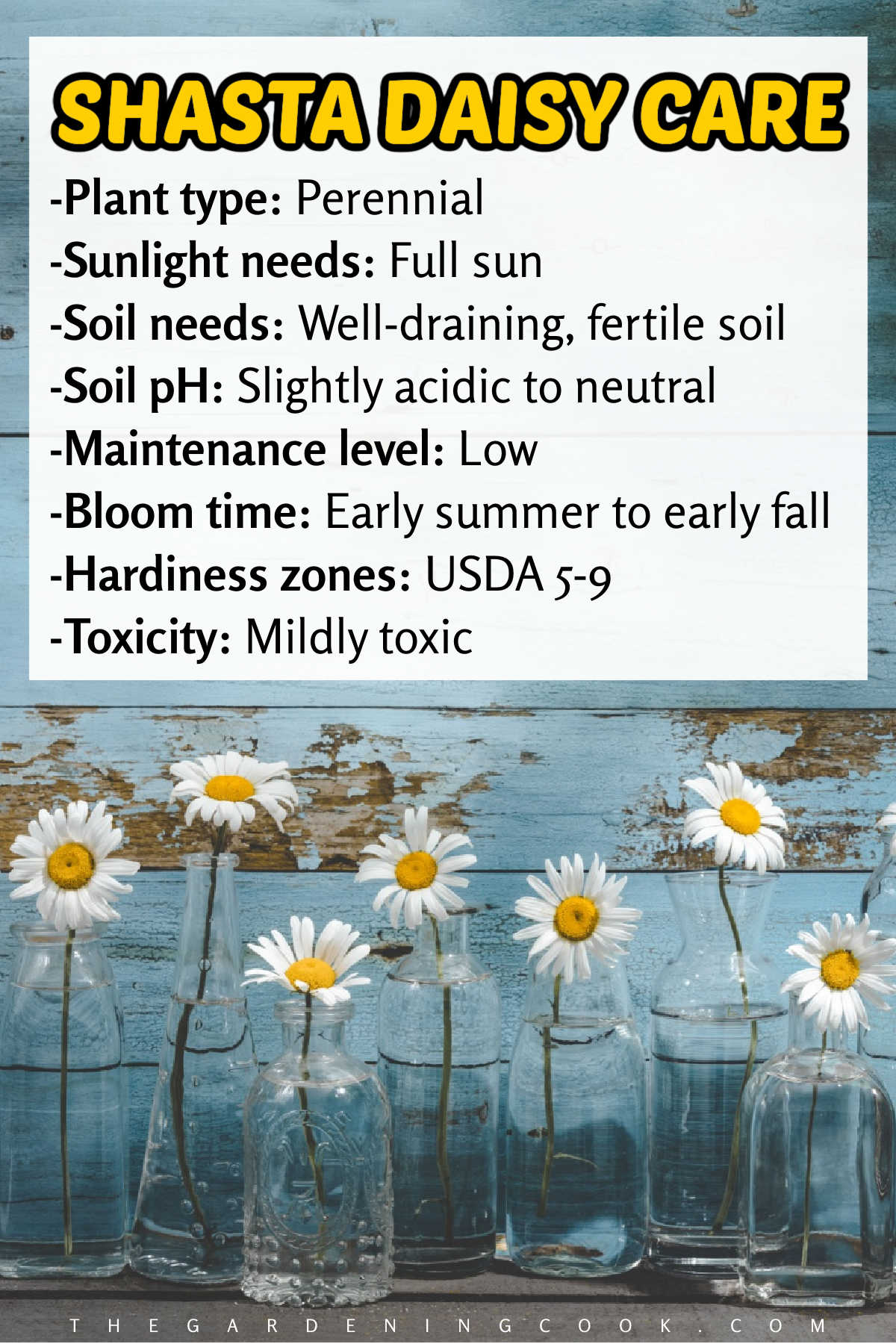
Leucanthemum × superbum (Shasta daisy) care
These growing tips will help you care for Shasta daisy perennials in your garden.
How much sunlight do Shasta daisies need?
Shasta daisy likes full sun, but can benefit from partial sunlight in the hottest climates.
Avoid planting them in full shade, as this will result in less prolific and more leggy blooms.
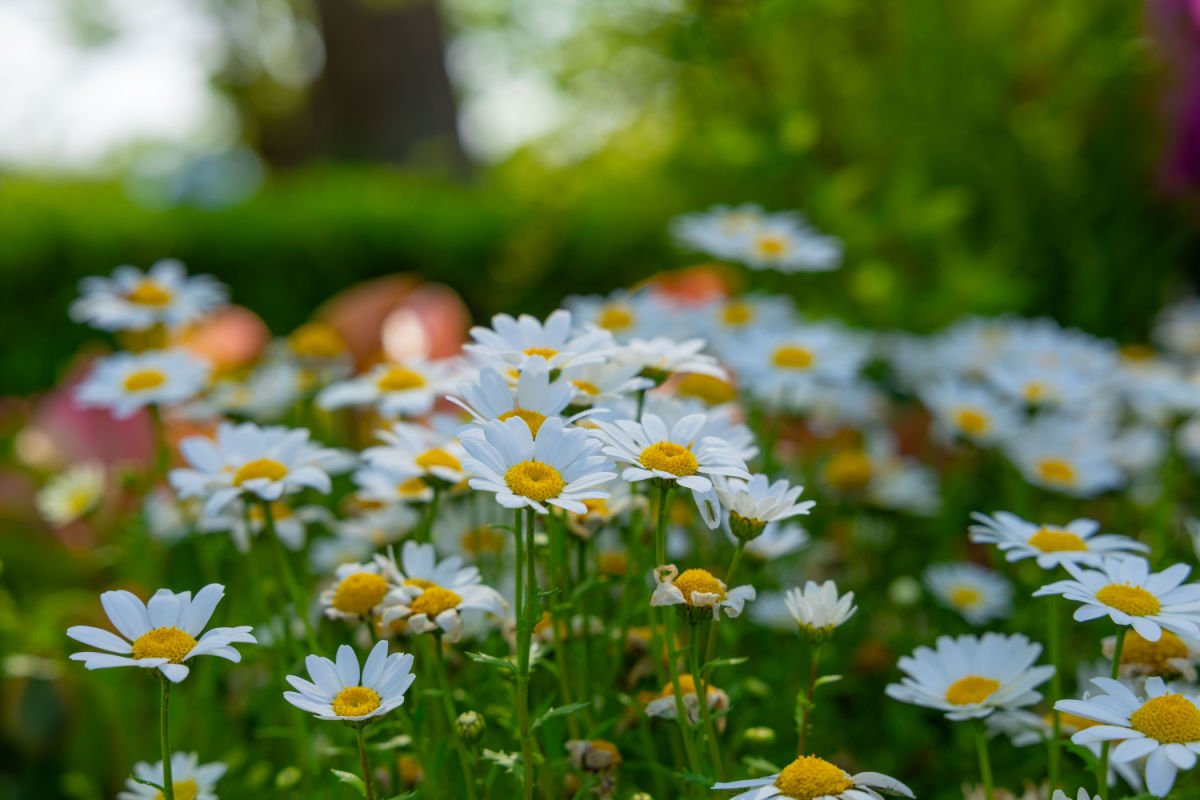
Soil requirements for Shasta daisy
Shasta daisy perennials need well-draining, fertile soil. This will not only produce bigger blooms but will also help the soil drain better, which can reduce the risk of root rot.
You can make your soil more fertile by adding manure, compost, mulch (bark, hay, wood chips, mulched leaves, or straw), and by growing cover crops in the late summer or fall.
How often should I water a Shasta daisy?
Leucanthemum × superbum is relatively drought-tolerant. As a general rule of thumb, it’s better to underwater Shasta daisies than it is to overwater them.
- Young plants need 1 inch (2.5 cm) of water a week.
- Be careful not to overwater since this can lead to root rot.
- Established Shasta daisy can tolerate limited periods of drought.
- With regular rainfall, Shasta daisies rarely need supplemental watering.
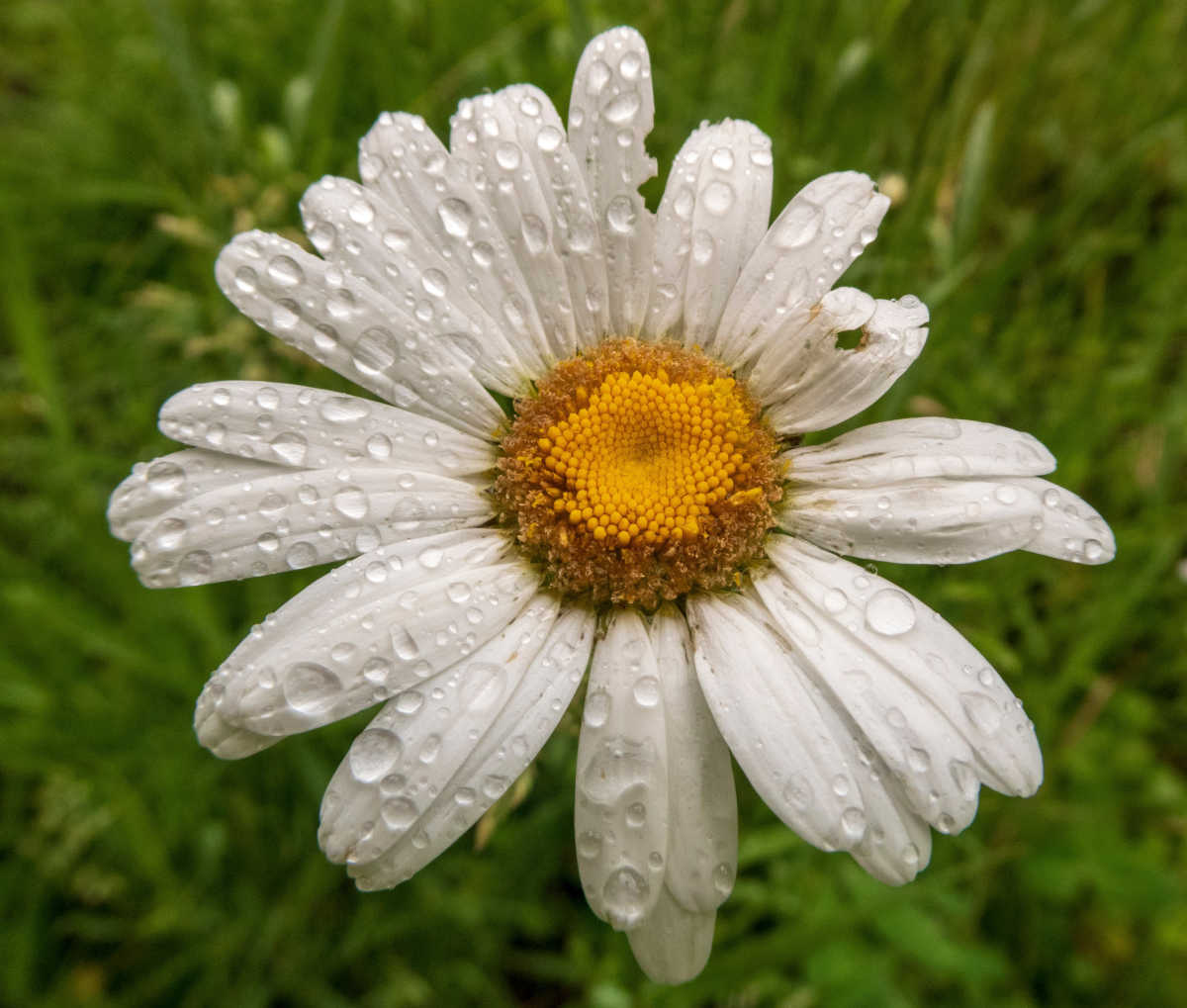
Fertilizing Shasta daisy
Shasta daisy perennials don’t require heavy fertilization.
- Feed the plant with a balanced, slow-release fertilizer in early spring.
- Use a fertilizer high in phosphorus in early summer to encourage more blooms.
Over-fertilizing can lead to fertilizer burn and reduced flowering.
Shasta daisy flowers
Shasta daisy flowers have pure white petals with yellow centers and dark, glossy leaves. The plant has an upright habit with stiff stems and flowers that sit above the foliage.
The plant flowers from early summer through early fall.
Depending on the variety, there can be quite a bit of variation in the petals. Some types have double flowers with multiple rows of petals, while others have filly or curly petals.

Some common varieties of Shasta daisy are:
- Becky – Longest blooming Shasta daisy with classic, single petals.
- Alaska – Large and full white flowers with yellow centers.
- Crazy Daisy – Thin, double, petals with a ruffled appearance.
- Daisy May – Produces prolific blooms and abundant side buds.
Pruning Shasta daisies
Proper pruning keeps Leucanthemum × superbum healthy and encourages a longer bloom time. It also prevents plants from becoming leggy and flopping over.

Remove any spent flowers to promote new blooms. Cut the stems back to the first set of healthy leaves.
At the end of the season, after blooming has finished, cut Shasta daisies back to 3-4 inches (7.5-10 cm) above the ground.
Shasta daisy winter care
Shasta daisies are hardy perennials, but taking a few steps at the end of the season to protect them during the winter ensures that your plant will be strong the following season.
- Add 2-3 inches (5-7.5 cm) of straw, shredded leaves, or mulch around the base of your trimmed plants.
- Move container plants to a sheltered location or wrap them with burlap.
- Water them lightly before the ground freezes.
These steps help prevent root damage and give your Shasta daisies a great start in the spring.
Shasta daisy propagation
Propagating Shasta daisies can be done in three ways: by planting Shasta daisy seeds, by division, and with stem cuttings.
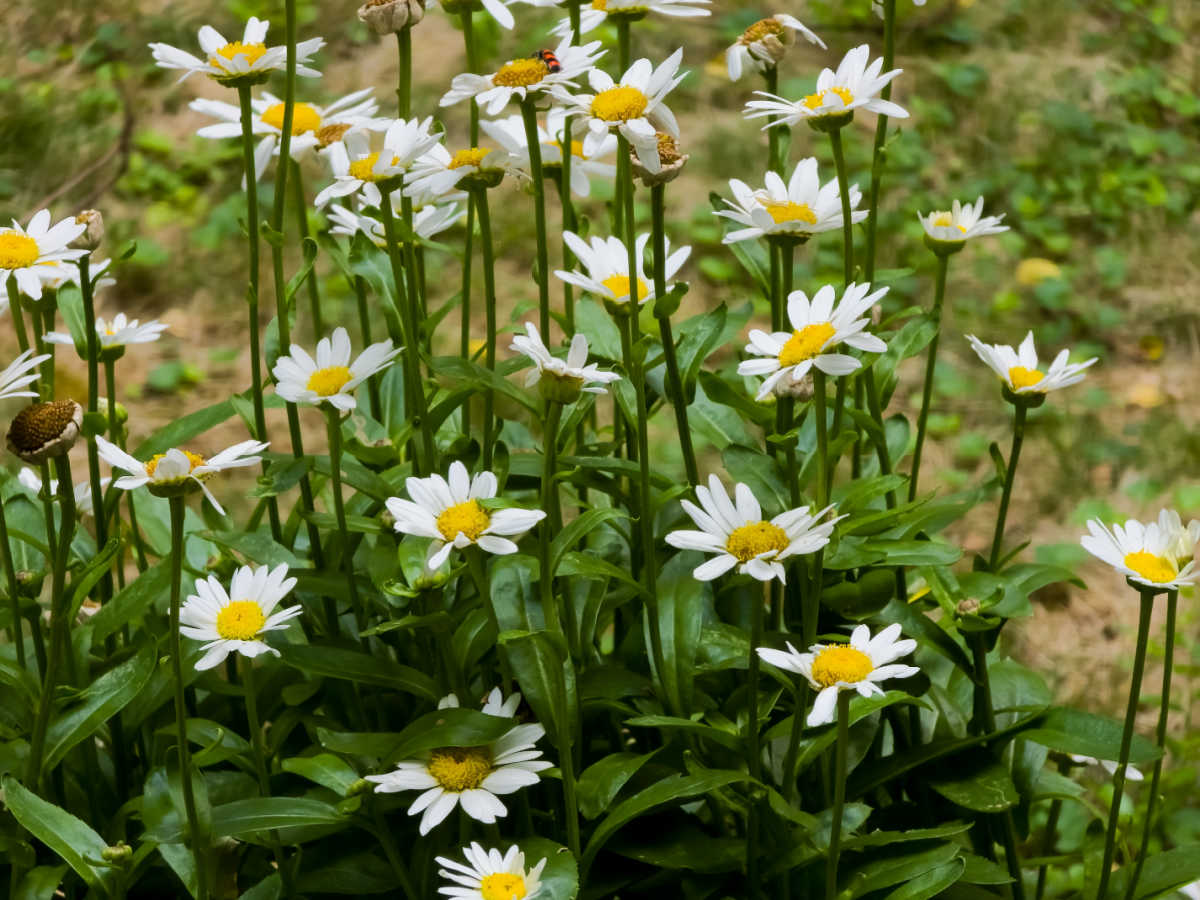
Division
The plant grows from rhizomes, which spread under the soil, so the size of the clump will increase fairly quickly. Once your clump of Shasta daisy plants is about 3 years old, it will become woody and die out in the center.
This is one of the reasons that Shasta daisies are considered short-lived perennials. To help them live longer, divide them in early spring when the plant starts to grow, or in fall after flowering is finished.
How to divide your Shasta daisies:
- Dig up the clump and discard the woody center.
- Separate the healthy sections from the center area.
- Replant these sections in your garden, spacing them 12-24 inches (30-60 cm) apart.
Stem cuttings
Taking stem cuttings, though possible, is a lesser-used method of Shasta daisy propagation.
- Cut 4-6 inches (10-15 cm) from the top of healthy, non-flowering stems in late spring or early summer.
- Remove the lower leaves, dip the cut ends in rooting hormone, and plant them in seed-starting soil.
- Keep the cuttings in bright, indirect light with slightly moist soil until roots develop, in about 3–4 weeks.
Shasta daisy pests and diseases
Generally speaking, Shasta daisies are low-maintenance when it comes to pests and diseases.
However, they could be susceptible to the following bugs:
To treat earwigs, mealybugs, and aphids, you can use neem oil. You can use organic slug pellets to deter slugs.
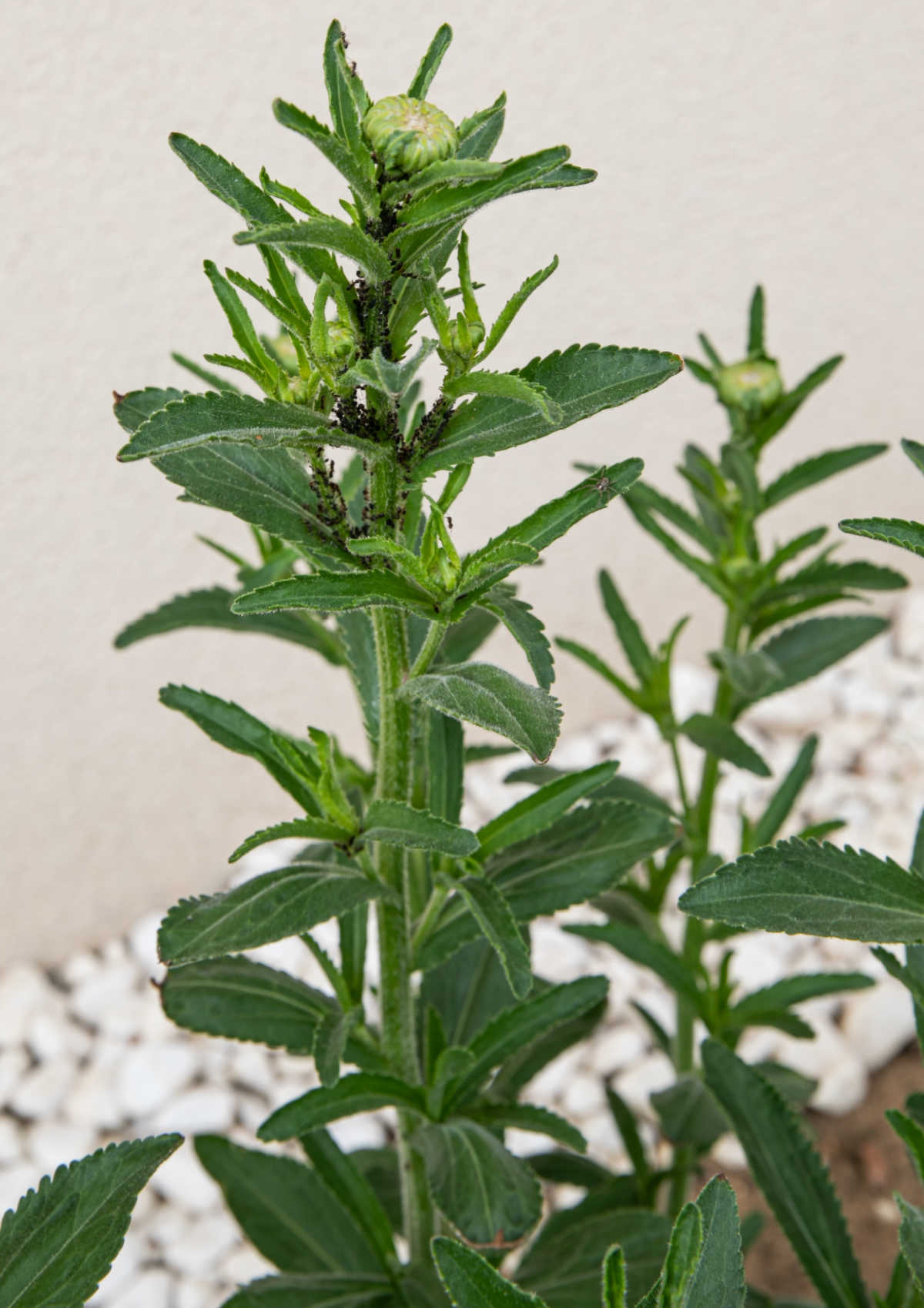
Overwatering can lead to fungal diseases, specifically bacterial leaf spot. To prevent this, make sure to give your plants good circulation and avoid overhead watering.
Shasta daisy plant care printable
If you’d like a reminder of how to grow Shasta daisy plants, you can print out a list of care tips as a high-resolution image here. You can also get the printable from the project card at the bottom of the post in a slightly smaller size.
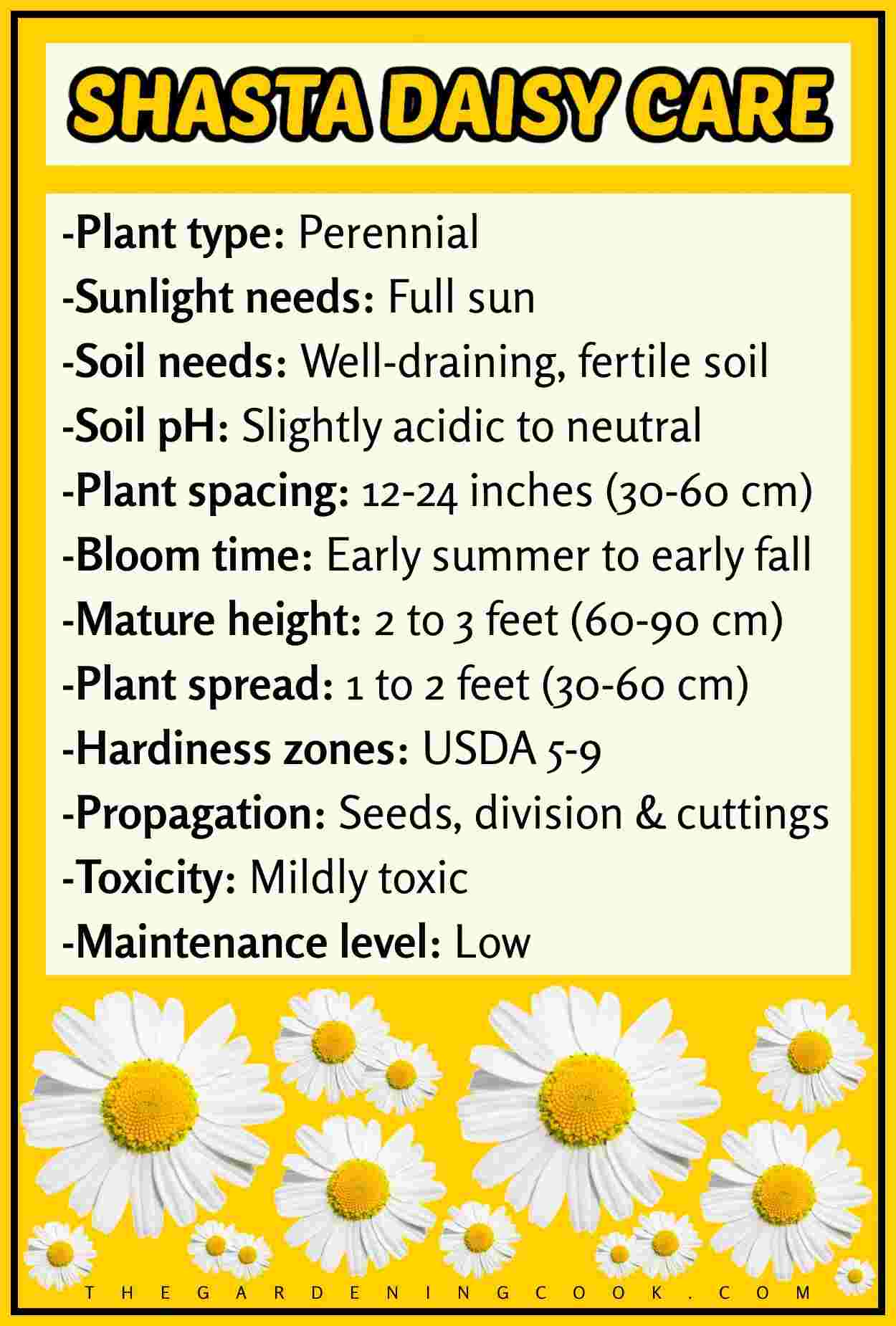
With the right care, Shasta daisies will reward you with cheerful blooms year after year—making them a timeless favorite for any perennial garden.
FAQ: Growing Shasta daisy plants
1. What are good companion plants for Shasta daisies?
Black-eyed Susans, coneflowers, daylilies, lavender, and hollyhocks all share similar sunlight and soil needs.
2. Is Shasta daisy a common English Daisy?
No, Shasta daisies (Leucanthemum x superbum) are taller and have larger flowers than English daisies (Bellis perennis).
3. Do Shasta daisies spread?
Yes, they naturalize easily and may take over a garden bed if not well-managed.
4. Do Shasta daisies attract butterflies?
Yes, their nectar-rich blooms attract both butterflies and bees.
5. Why are my Shasta daisies falling over?
Tall varieties may need staking and protection from strong winds to prevent floppy stems.
6. What is the meaning of Shasta daisies?
Shasta daisies are often associated with innocence, purity, and hope, thanks to their white petals and cheerful yellow centers.
7. Are Shasta daisies good as cut flowers?
Yes, they make excellent cut flowers, which can last up to a week in a vase.
8. Are Shasta daisies deer-resistant?
While no plant is completely safe from deer, Shasta daisies are considered deer-resistant because they have a bitter taste.
9. Why is it called Shasta daisy?
It’s named after Mount Shasta, a snowcapped mountain in Northern California.
Share this guide about growing Shasta daisies on X
If you enjoyed learning about the care of Shasta daisy plants, why not share this guide with a friend? Here is a post to get you started:
🌼 Add a pop of sunshine to your garden with Shasta daisies. Head to The Gardening Cook for tips on planting, watering, pruning & propagating. 🌱💧✂️☀️#GardeningTips #Perennials #GardenFlowers #FlowerCare #Leucanthemum #ShastaDaisy Share on XPin this Shasta daisy care guide
Would you like a reminder of these tips for Shasta daisy care? Pin this image to one of your gardening boards on Pinterest so that you can easily find it later.
You can also watch this YouTube slideshow video about the care of Shasta daisy plants.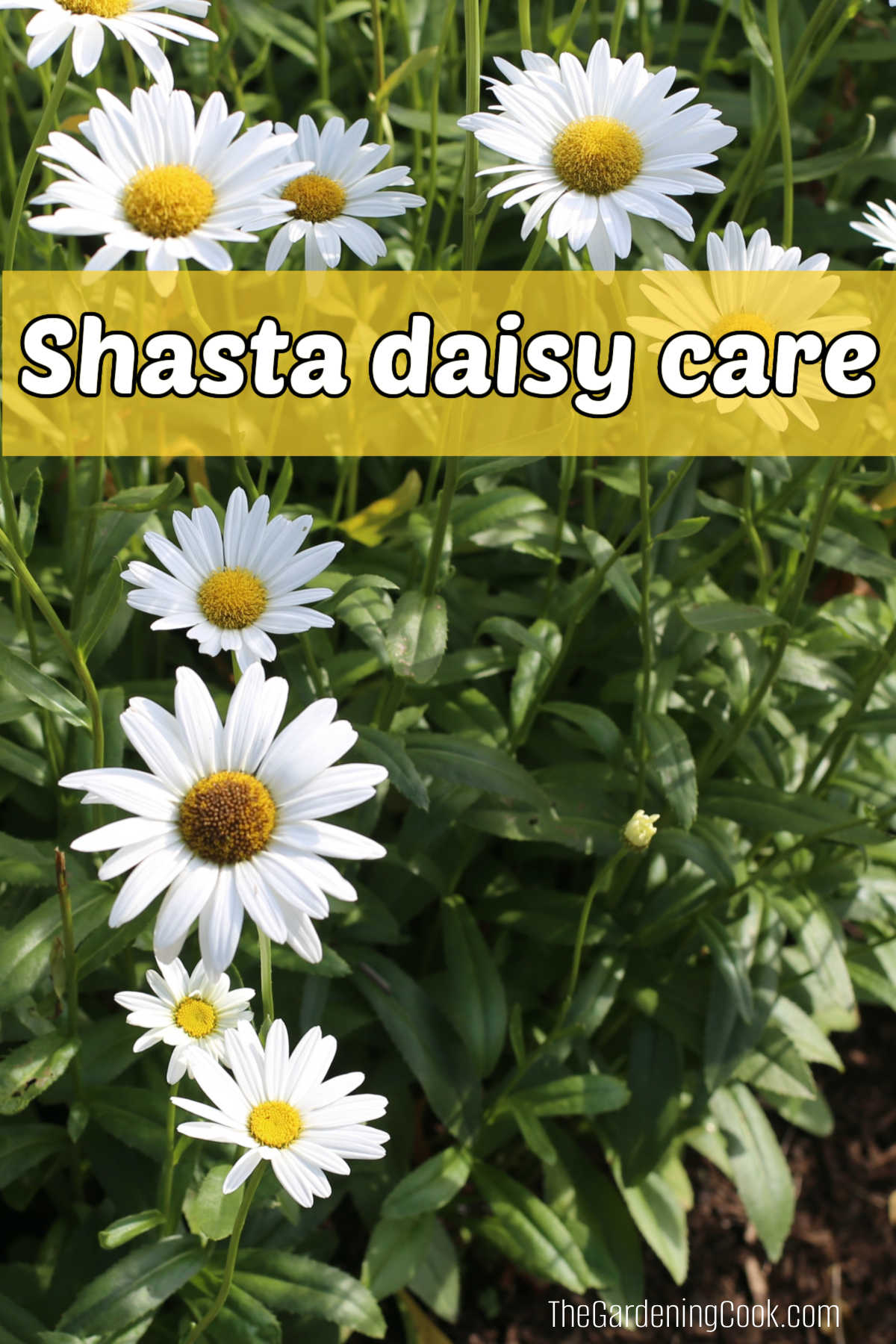
Admin note: This article about how to care for Shasta daisies first appeared on the blog in June 2018. This post has been updated to add all new photos, a free Shasta daisy care printable, and a slideshow video.
How to Care for Shasta Daisies

Shasta daisies are low-maintenance perennials featuring flowers with white petals and yellow centers.
The plant is a commonly used in English cottage gardens.
Print out the Shasta daisy plant care instructions and the free printable to save for future reference.
Materials
- Shasta daisy plant
- Organic matter or compost
- Mulch
Tools
- Hose or watering can
Instructions
- Dig holes for Shasta daisy plants 1-2 feet (30-60 cm) apart, or scatter seeds and rake them into the soil.
- The soil needs to be well-draining and fertile.
- Prepare the soil by adding compost or other organic matter.
- Choose a spot that gets 6+ hours of sunlight each day.
- Water well to get the plant established, and then it is quite drought-tolerant.
- Mulch the soil so that you don't have to water as often.
- The plant is cold-hardy in zones 5-9.
- Propagate by division in spring or fall. You can also propagate with stem cuttings.
- It flowers from early summer to early autumn.
- Protect tall plants from high winds.
- Deadhead often for more blooms.
Notes
You can use this link to print out the growing tips for Shasta daisies, as a high-resolution image using the print feature in your browser window.

Recommended Products
As an Amazon Associate and member of other affiliate programs, I earn from qualifying purchases.

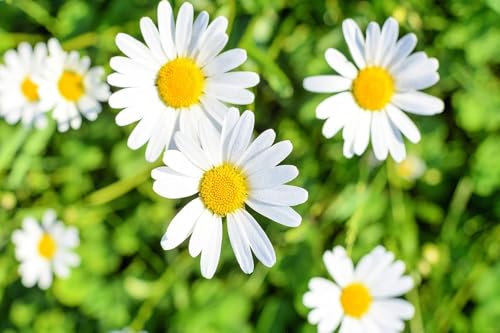
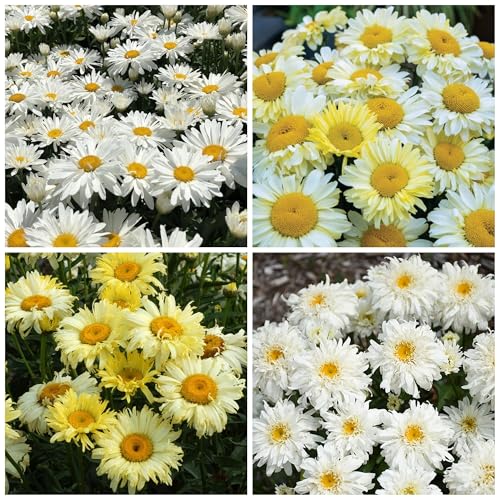
Corey
Wednesday 30th of November 2022
Great Article! Thank you! Do you think zone 9B in Florida may be too hot to grow Shasta daisies? I have germinated the Alaska variety
Carol Speake
Sunday 4th of December 2022
HI Corey. In my experience, even here in zone 7b in North Carolina, the Shasta daisy does best before it gets too hot. I would think Florida temps would be too much for the plant to deal with for most of the year. Zone 5 to 8 is the recommended range.
Beverly Millimen
Thursday 19th of May 2022
My Shasta looks dead There is no leaves no flowers nothing is blooming I think it got root rotted
ER
Monday 26th of July 2021
My Shasta daisys look beautiful but now some of the outer stems are laying towards the ground. What is wrong?
Carol Speake
Tuesday 27th of July 2021
Are they the stems that have flowered? It's normal for those to lay down when the blooms are done.
Rhonda
Sunday 30th of May 2021
Hi Carol After dead heading, I clipped the heads off. Are the seeds in the heads good for Planting? Please advise.
Carol Speake
Sunday 30th of May 2021
Place the Shasta daisy seeds into a paper envelope. Store in a cool, dry location out of direct light until planting time. Shasta daisy seeds can be sown in early winter through late spring.
peggy hopf
Monday 22nd of March 2021
How do I get the grass that’s growing in my Shasta daisies out of there?
Carol Speake
Monday 22nd of March 2021
The only way that I know of to get out weeds that are connected to thye root ball is to dig up the plant and gently pry the roots apart and take out the weeds and replant.